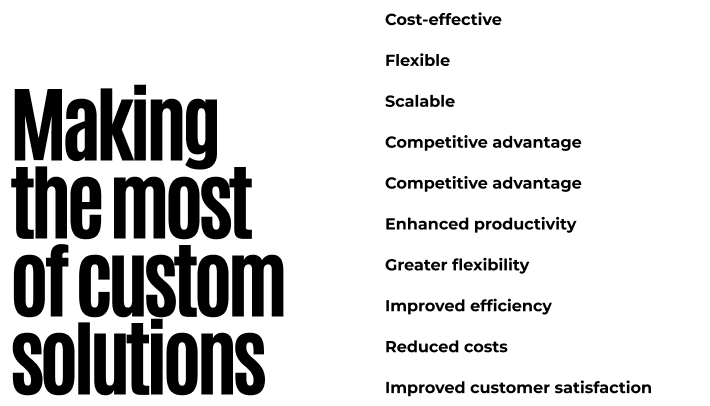Any company needs various solutions to perform their activities. That can be CRM, planners, smart office solutions, schedulers, and dozens of others. But where you can find the right custom software that will positively impact your business processes and possible income?
What is a customized solution?
Custom software is created for a specific organization and is mostly compared to out-off-the-box software designed for general operational needs. Engineers develop them in machine programming languages such as C, C++, Java, Ruby on Rails, and Python.
Nowadays every organization, either a small team of enthusiasts or a big company with several departments and offices searches for unique digital solutions for efficient and productive work. Depending on business needs and ambitions, teams prefer out-of-the-box or unique customized software solution items.
Custom software offers unlimited possibilities and independence in the development of services that 100% suit the company’s unique requirements, ambitions, plans, and internal processes.
The development process comprises common development stages of coding, testing and implementation using modern development models: Waterfall, Kanban, Scrum, Lean, or DevOps.
It is usually dedicated to a third-party company or outsourced to an offshore developers team. Such a transfer of responsibilities is made to make the development process cost-efficient. Just think: we tend to buy clothes in a specialized department, instead of making it on our production factory. Besides, according to research on global outsourcing by Deloitte, 59% of companies consider outsourcing cost-reducing software. The IT sector has the highest outsourcing rate, peaking at 72%.
Once a unique tool has been implemented, it has to be supported during its lifetime and modernized when the company grows.
Why custom software is important?
The best practices of choosing to develop vs. buy software result in several key-important points:
- Effectiveness – as you want to implement a unique solution, e.g. a web platform, managing your internal training processes for your employees, you get the features that your particular team needs. Hence resulting in effective time and resources planning and distribution.
- Competitiveness – while choosing software packages, you have the same digital opportunities as your competitors. But something custom gives you the advantage to outstand your rivals.
- Cost efficiency – when you decide to develop software by following your internal operational requirements, you decide first of all if it is worth its money. The design of all the functional features and modules can be too expensive. Eventually, you get a solution with your ownership, and no licensing is required, so that in the future you can sell it. This is closely connected with the testing period. During it, your employees test the solution, and in such a way, get more familiar with it, so less time is spent on learning. Thus, your employees distract less from doing their job.
- Scalability – as your company grows, your operating business processes scale as well. But when you use customized digital technologies in your business, you can easily and relatively fast modernize it by following up to date demands.

3 major keys to effective custom software development
Based on years of experience in customized web and mobile solutions, we can offer our definition of major steps to successful development. These rules apply to custom software development as well. Once you revise all the points and have all the answers, and you truly need it, get ready for unlimited opportunities ahead with your unique solution.
1. Choose the right developer
To specify the idea mentioned before, choosing a contracting team or dedicating the development of your software solution to an offshore team best suits digital business needs. It fits your budget, due to low costs, effective due to high expertise of the team you choose, and productive, since your in-house team of engineers won’t waste precious time on research and development of your tool.

Once you’ve made your choice, mind that the developer has to provide their model or work, timelines and budget estimate, project management, and delivery, communicating means, and all the necessary documentation.
2. Documentation and requirements
To help the developer fully understand your requirements, your task is to dedicate much time consulting with your team on:
- what your current processes are,
- why you need modernization, and
- what you want to be designed.

You need to define the requirements to feel sure they meet your particular needs while staying on the calendar and within budget. Once you have the answers described in a written form, pass them to your developer to define App development stages.
3. Technologies to consider
When your planned custom software development is estimated to last for a year or more, consider the technological trends. You should stay tuned, so revolve popular programming languages. Choose those that are among the top instilling trust among the development community for productivity, cost control, speed, and on-demand convenience, like Python, Ruby on Rails, .NET or Java. Mobile application technology may also be fundamental.

54 % of global executives believe that customer buying behaviour is shifting from products and services to experiences, IBM representatives’ state. Many of these experiences occur through mobiles. Hence, the major responsibility of the developer is to deliver the best user experience, along with unique digital opportunities on mobiles.
Now, when you are aware of why custom software is important, know how to decide if your business needs it, and prepare for it most effectively, it is time to start your project. Outrun your competitors with a single solution hitting your goals. And contact us to get your product ready in a right way.


















